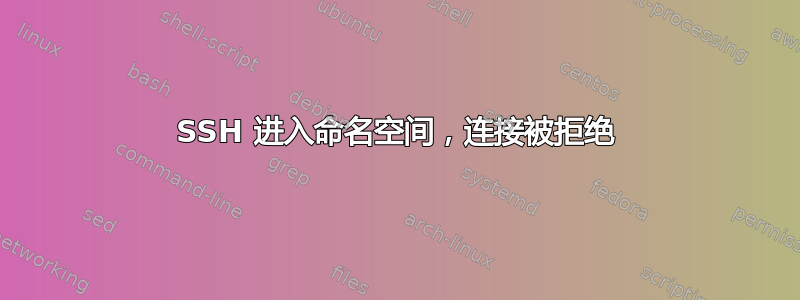
我有一个 Ubuntu 服务器,它有两个网络接口和一个名为“bluewire”的命名空间(以连接到它的以太网电缆的颜色命名)。
bluewire 命名空间已添加 enp4s0 接口,并与 WAN 隔离(这是理想的)。我可以使用 PuTTY 从我的桌面通过 192.168.1.1:22 SSH 进入服务器本身,但当我尝试通过 192.168.1.2:22 连接时,PuTTY 会抛出“连接被拒绝”错误。我怀疑命名空间根本没有监听任何端口。
难题:如何在命名空间内启用监听,以便通过蓝线 SSH 接入?或者,如果这不是监听问题,我需要做什么才能使 SSH 通过蓝线工作?
附加信息:
- UFW 在服务器端和
ip netns exec bluewireOpenSSH 端均开放。 iptablesbluewire 命名空间的规则是开放的(一切都设置为)ACCEPT。- 可以从 .2 地址 ping 服务器,但它只是拒绝连接。运行 后
ip netns exec bluewire tcpdump -n dst port 22,我可以假设服务器知道它正在接收来自桌面的请求。 - 运行后
netns -an发现服务器本身正在监听端口 22,但ip netns exec bluewire netstat -an结果却是一个空表。我怀疑问题就出在这里。 - 如果你想知道我为什么要有这样的设置:红线将服务器连接到互联网,而蓝线则与互联网隔离。原因是,如果我怀疑我的服务器受到攻击(例如我的私钥被盗),那么我可以断开或断开
ifdown红线接口并限制服务器对本地网络的访问,这样我只能通过桌面 SSH 来更改锁。
编辑
根据 Blerg 下面的留言,截图如下netstat -plunt

这两个接口都可以通过我的桌面上的 Windows cmd 进行 ping 操作。
据我所知,路由器没有阻止内部网络的任何端口;它只是阻止了来自外界的所有访问,除了 1194,我将其用于 OpenVPN。我可以使用桌面 PuTTY 通过 .1 接口连接,没有任何问题,所以我怀疑路由器是罪魁祸首……也许吧。
我的
/etc/ssh/sshd_config文件[07:28]<~ @ > $ cat /etc/ssh/sshd_config # Package generated configuration file # See the sshd_config(5) manpage for details # What ports, IPs and protocols we listen for Port 22 # Use these options to restrict which interfaces/protocols sshd will bind to #ListenAddress :: ListenAddress 192.168.1.1 ListenAddress 192.168.1.2 Protocol 2 # HostKeys for protocol version 2 HostKey /etc/ssh/ssh_host_rsa_key HostKey /etc/ssh/ssh_host_dsa_key HostKey /etc/ssh/ssh_host_ecdsa_key HostKey /etc/ssh/ssh_host_ed25519_key #Privilege Separation is turned on for security UsePrivilegeSeparation yes # Lifetime and size of ephemeral version 1 server key KeyRegenerationInterval 3600 ServerKeyBits 1024 # Logging SyslogFacility AUTH LogLevel INFO # Authentication: LoginGraceTime 120 PermitRootLogin prohibit-password StrictModes yes RSAAuthentication yes PubkeyAuthentication yes #AuthorizedKeysFile %h/.ssh/authorized_keys # Don't read the user's ~/.rhosts and ~/.shosts files IgnoreRhosts yes # For this to work you will also need host keys in /etc/ssh_known_hosts RhostsRSAAuthentication no # similar for protocol version 2 HostbasedAuthentication no # Uncomment if you don't trust ~/.ssh/known_hosts for # RhostsRSAAuthentication #IgnoreUserKnownHosts yes # To enable empty passwords, change to yes (NOT RECOMMENDED) PermitEmptyPasswords no # Change to yes to enable challenge-response passwords (beware issues with # some PAM modules and threads) ChallengeResponseAuthentication no # Change to no to disable tunnelled clear text passwords PasswordAuthentication no # Kerberos options #KerberosAuthentication no #KerberosGetAFSToken no #KerberosOrLocalPasswd yes #KerberosTicketCleanup yes # GSSAPI options #GSSAPIAuthentication no #GSSAPICleanupCredentials yes X11Forwarding yes X11DisplayOffset 10 PrintMotd no PrintLastLog yes TCPKeepAlive yes #UseLogin no #MaxStartups 10:30:60 Banner /etc/issue.net # Allow client to pass locale environment variables AcceptEnv LANG LC_* Subsystem sftp /usr/lib/openssh/sftp-server # Set this to 'yes' to enable PAM authentication, account processing, # and session processing. If this is enabled, PAM authentication will # be allowed through the ChallengeResponseAuthentication and # PasswordAuthentication. Depending on your PAM configuration, # PAM authentication via ChallengeResponseAuthentication may bypass # the setting of "PermitRootLogin without-password". # If you just want the PAM account and session checks to run without # PAM authentication, then enable this but set PasswordAuthentication # and ChallengeResponseAuthentication to 'no'. UsePAM yes [07:29]<~ @ > $
答案1
对于那些感兴趣的人,我从这里找到了解决方案:https://blog.bofh.it/debian/id_446。
诀窍是在每个命名空间中启动一个单独的 sshd 服务器:
ip netns exec mynamesapce /usr/sbin/sshd -o PidFile=/run/sshd-mynamespace.pid
当然防火墙必须允许 tcp/ssh
答案2
从您的帖子中我可以看出,您的 SSH 守护程序可能只在一个接口上监听。在您的/etc/ssh/sshd_config文件中,请确保您已ListenAddress列出以下内容:#ListenAddress。如果启用了此功能,OpenSSH 服务器将只监听指定地址上的传入连接。如果您想对多个 IP 使用 ListenAddress,则需要将它们放在单独的行上,如下所示:
监听地址 192.168.1.1 监听地址 192.168.1.2



